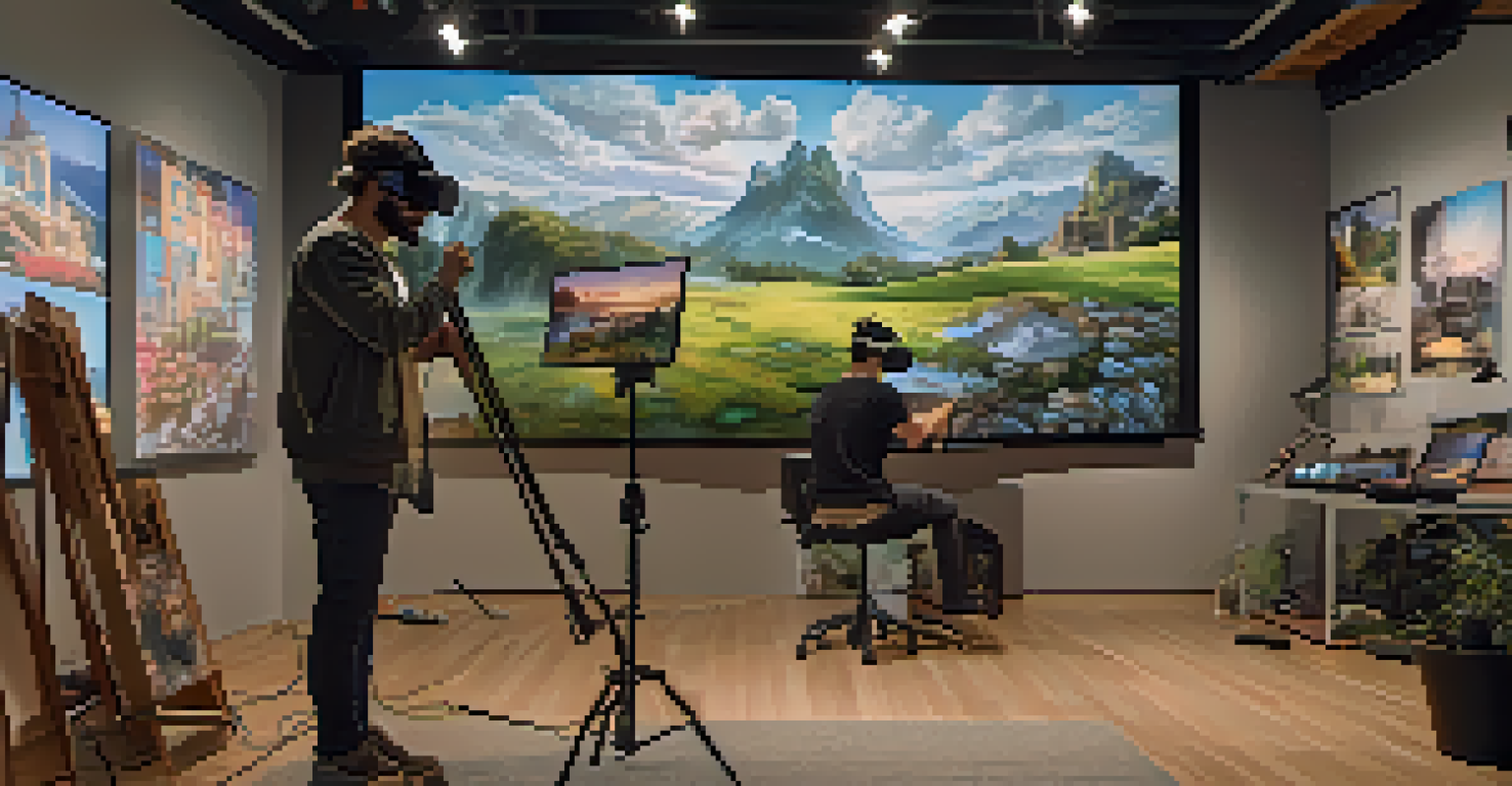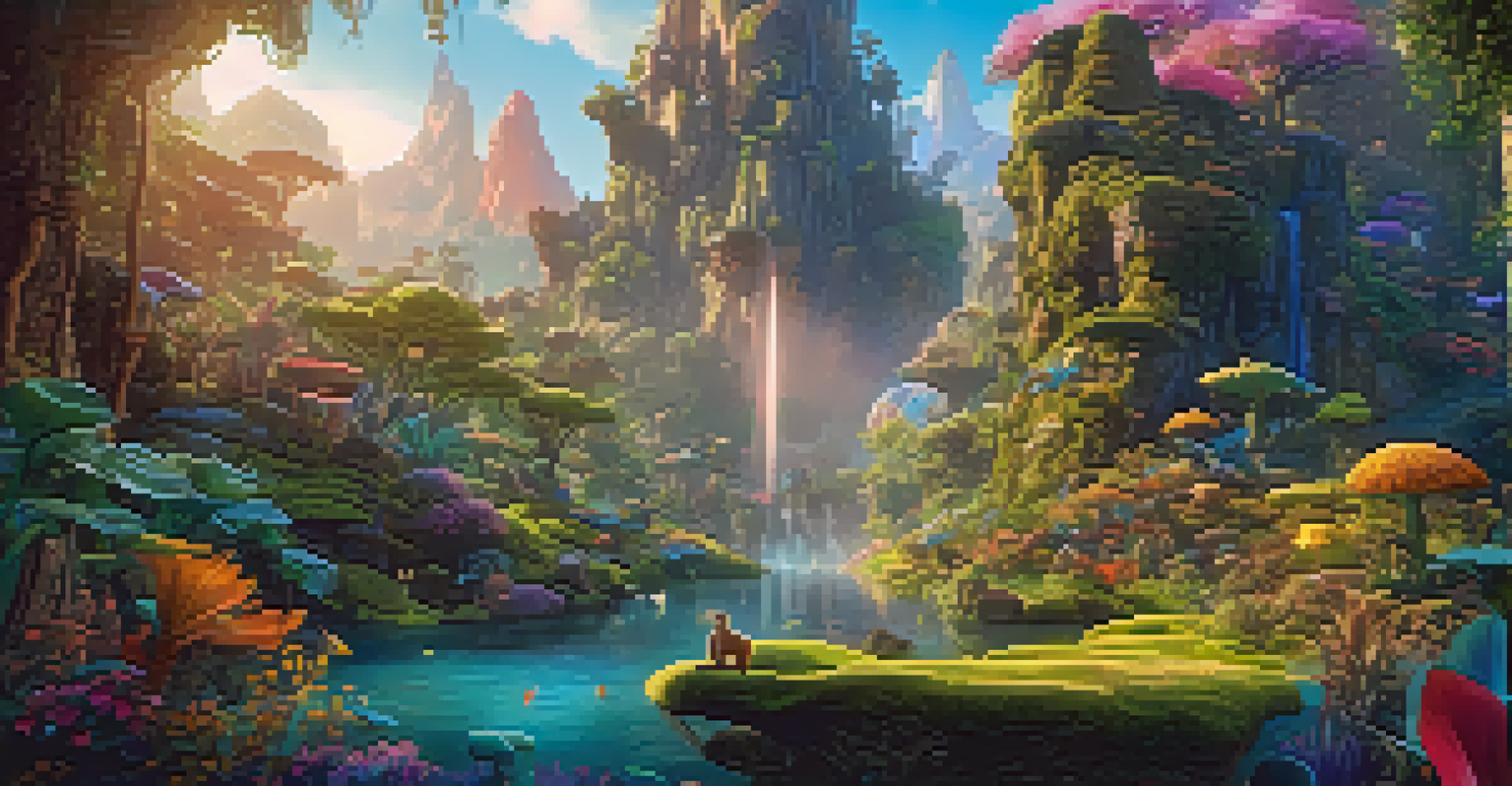Using Virtual Reality in Film: A New Frontier for Storytelling

What is Virtual Reality and How Does It Work in Film?
Virtual reality (VR) is an immersive technology that allows users to experience computer-generated environments as if they were real. In the context of film, VR enables viewers to step inside the story, experiencing it from a first-person perspective. By using VR headsets, audiences can look around and engage with the environment, making them feel like active participants rather than passive viewers.
Virtual reality is not just a new technology; it's a new way of storytelling.
This level of immersion is achieved through a combination of 3D graphics, spatial audio, and sometimes even haptic feedback. For instance, when a character turns their head or moves, the VR environment reacts accordingly, enhancing the storytelling experience. This creates a unique platform where filmmakers can explore new narrative techniques and engage audiences on a deeper level.
The key to successful VR storytelling lies in crafting experiences that are not only visually stunning but also emotionally resonant. Filmmakers can transport viewers into different worlds, allowing them to connect with characters and stories in ways traditional films cannot.
The Evolution of Storytelling Techniques with VR
Traditionally, storytelling has relied on linear narratives where viewers follow a predetermined path. However, VR offers a more dynamic approach, allowing for branching storylines where choices impact the outcome. This interactivity invites viewers to explore narratives at their own pace, creating a personalized experience. Imagine being able to walk through a scene and decide which character to follow—this is the future of storytelling.

Moreover, VR can integrate multi-sensory elements, such as sound and touch, to deepen the emotional connection to the story. For example, in a horror VR film, the sound of footsteps approaching can heighten tension, while the sensation of wind can make the environment feel more real. This multisensory approach challenges filmmakers to think creatively about how to engage their audience.
VR Transforms Storytelling Techniques
Virtual reality enables dynamic, interactive narratives that allow viewers to make choices and engage with characters like never before.
As filmmakers experiment with VR, they are discovering new ways to tell stories that resonate on a personal level. This shift encourages innovative thinking and pushes the boundaries of traditional filmmaking, leading to unique and unforgettable experiences.
Examples of Successful VR Films
Several films have successfully embraced virtual reality, showcasing the potential of this medium. One standout example is 'The Invisible Man,' which, in a VR adaptation, allows viewers to experience the narrative from the perspective of the protagonist, amplifying the suspense and immersion. Such adaptations demonstrate how VR can transform existing stories into interactive experiences.
The future of storytelling lies in immersive experiences that allow audiences to step inside the narrative.
Another notable example is 'Wolves in the Walls,' a VR short film that invites viewers into the mind of a young girl as she confronts her fears. This film effectively uses VR to explore psychological themes, making the audience feel as though they are part of the girl's journey. The ability to inhabit a character’s perspective creates a profound emotional impact that traditional films struggle to achieve.
These examples illustrate the versatility of VR in film, proving that it can enhance storytelling across genres—from horror to fantasy. With ongoing advancements in technology, the potential for future VR films is limitless.
Challenges Filmmakers Face in VR Production
While the potential of VR in film is vast, it comes with its own set of challenges. One major hurdle is the technical complexity involved in producing VR content. Filmmakers must navigate new equipment, software, and editing techniques that differ significantly from traditional filmmaking. This learning curve can be daunting, especially for those accustomed to conventional methods.
Additionally, creating captivating VR experiences requires a shift in storytelling techniques. Filmmakers must consider viewer agency and how to guide audiences through a non-linear narrative without losing engagement. Balancing interactivity with coherent storytelling is a delicate task that not all creators are prepared for, leading to mixed results in VR projects.
Successful VR Films Showcase Potential
Films like 'The Invisible Man' and 'Wolves in the Walls' demonstrate how VR can enhance storytelling by immersing audiences in unique experiences.
Lastly, the accessibility of VR technology poses another challenge. While VR headsets are becoming more common, not everyone has access to the equipment needed to enjoy these films. This limitation can restrict the audience reach, making it essential for filmmakers to consider how to create inclusive experiences.
The Role of Audience Engagement in VR Storytelling
Audience engagement is at the heart of VR storytelling. Unlike traditional films, where viewers simply watch the action unfold, VR invites them to explore and interact with the narrative. This interactive element fosters a stronger emotional connection, as viewers feel more involved in the story rather than just observers. The ability to make choices and explore environments adds a layer of investment that traditional media often lacks.
Moreover, audience feedback plays a significant role in shaping future VR experiences. Filmmakers can learn from viewer interactions and preferences, tailoring content to enhance engagement further. For example, if a particular storyline or character resonates well, creators can build on that success in future projects, resulting in a more satisfying experience for audiences.
Ultimately, the success of VR storytelling hinges on understanding and prioritizing audience engagement. The more filmmakers can create immersive and interactive experiences, the more likely they are to captivate viewers and keep them coming back for more.
Future Trends in Virtual Reality Filmmaking
As technology continues to evolve, so will the possibilities for virtual reality in filmmaking. One emerging trend is the integration of artificial intelligence (AI) to enhance interactivity and personalization in VR experiences. Imagine a VR film where AI adapts the storyline based on viewer choices and reactions, creating a truly unique experience each time. This level of customization could revolutionize how stories are told.
Another trend is the collaboration between filmmakers and gaming companies to create hybrid experiences. By merging elements of gaming with cinematic storytelling, producers can develop rich, interactive narratives that keep audiences engaged for hours. This cross-pollination of ideas is likely to lead to innovative projects that redefine the boundaries of both industries.
Challenges in VR Film Production
Filmmakers face technical complexities and the need for new storytelling strategies when creating captivating VR content.
As VR technology becomes more accessible and mainstream, we can expect an influx of diverse voices and stories in the medium. This democratization of filmmaking will allow underrepresented creators to share their unique perspectives, enriching the landscape of virtual reality storytelling.
Conclusion: Embracing the Future of Storytelling
Virtual reality is more than just a passing trend; it represents a fundamental shift in how stories can be told and experienced. By breaking free from the constraints of traditional filmmaking, VR opens up new avenues for creativity and audience engagement. Filmmakers who embrace this technology may find themselves at the forefront of a storytelling revolution.
As we continue to see advancements in VR technology, it’s essential for creators to remain adaptable and open-minded. The potential for immersive storytelling is vast, and those willing to explore and experiment will likely lead the charge into this new frontier. Just as cinema evolved with sound and color, so too will it evolve with virtual reality.

In conclusion, the future of storytelling lies in the hands of those willing to harness the power of virtual reality. By embracing this innovative medium, filmmakers can create unforgettable experiences that resonate with audiences on a deeper level, making every story not just watched, but truly felt.